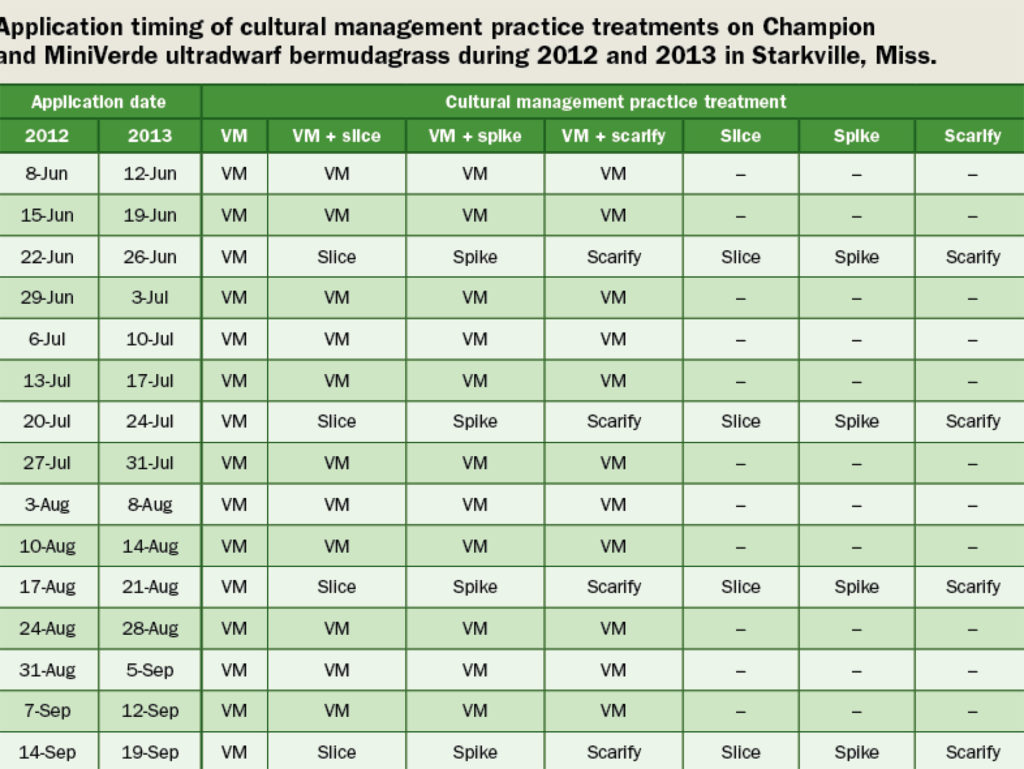Leaf spot and dollar spot on ultradwarf bermudagrass greens

Leaf spot disease symptoms on an ultradwarf bermudagrass putting green. (Photo: Maria Tomaso-Peterson)
Ultradwarf bermudagrass (Cynodon dactylon x C. transvaalensis) is the predominant putting green turf in the southern U.S. This grass, however, produces profuse amounts of thatch, which leads to increased disease pressure from leaf spot (Figure 1), caused by Bipolaris cynodontis, and dollar spot (Figure 2), caused by Clarireedia monteithiana (syn. Sclerotinia homoeocarpa).
Disease management programs typically include strategic implementation of resistant turfgrass cultivars, cultural management practices and chemical pesticide applications. The objective of this research was to better understand how each of these management factors influences leaf spot and dollar spot of ultradwarf bermudagrass.
Evaluating strategies
We conducted experiments in 2012 and 2013 on 4-year-old ultradwarf bermudagrass turf at Mississippi State University in Starkville, Miss. The turf was maintained to golf course putting green standards, with daily mowing at 0.10 to 0.15 inch.

Dollar spot disease symptoms on an ultradwarf bermudagrass putting green (Photo: Maria Tomaso-Peterson)
Cultivar resistance
We included Champion and MiniVerde ultradwarf bermudagrass cultivars in our study to represent two commonly used cultivars at the time of the study.
Cultural management practices
We applied cultural management practice treatments using the True-Surface Trekker Greens Care Collection inserts by Turfline. The cultural management practices we included were as follows:
1. Standard weekly applications of vertical mowing (VM) using the Vacu-Cutter insert at 0.15 inch below the cutting height and blades spaced 0.4 inches apart. We applied this treatment weekly in two perpendicular directions.
2. Weekly applications of vertical mowing with once-monthly substitutions of slice (VM plus slice). We made weekly vertical mowing applications using the Vacu-Cutter insert as described for treatment 1, and we made slice applications in a single direction (direction changed each month) using the Deep Slicer insert at a 0.75-inch depth with blade spacing 1.5 inches apart.
3. Weekly applications of vertical mowing with once-monthly substitutions of spike (VM plus spike). We made weekly vertical mowing applications using the Vacu-Cutter insert as described for treatment 1 and made spike applications in a single direction (direction changed each month) using the Greens Spiker insert at a 0.75-inch depth with spikes spaced 2.4 inches.

Table 1 Application timing of cultural management practice treatments on Champion
and MiniVerde ultradwarf bermudagrass during 2012 and 2013 in Starkville, Miss.
4. Weekly applications of vertical mowing with once-monthly substitutions of scarify (VM plus scarify). We made weekly vertical mowing applications using the Vacu-Cutter insert as described for treatment 1 and made scarify applications in a single direction (direction changed each month) using the Vacu-Scarifier insert at a 0.4-inch depth with 1.5-inch blade spacing.
5. Once-monthly applications of slice alone using the Deep Slicer insert as described for treatment 2.
6. Once-monthly applications of spike alone using the Greens Spiker insert as described for treatment 3.
7. Once-monthly applications of scarify alone using the Vacu-Scarifier insert as described for treatment 4.

Figure 3 Mean leaf spot severity of Champion and MiniVerde ultradwarf bermudagrass from June to November 2012 and 2013 in Starkville, Miss., presented with and without the presence of a seasonal fungicide application. Leaf spot severity was determined by a visual estimation of percentage symptomatic area (0-100 percent).
Application timing of the cultural management practices is described in Table 1.
Chemical control
The fungicide treatments in the study were either the application of a seasonal fungicide program or no application of a seasonal fungicide program. We designed the seasonal fungicide program to resemble a typical fungicide spray regime employed by golf course superintendents managing ultradwarf bermudagrass in the Deep South at the time of the study. The seasonal fungicide program is described in Table 2.
Our findings
Cultivar resistance
There were differences between the two cultivars in our study with respect to leaf spot and dollar spot resistance. When fungicides were applied, leaf spot was similar on Champion and MiniVerde (Figure 3). However, when fungicides were not applied, more leaf spot was observed on Champion than MiniVerde (Figure 3). Similarly, during both years of our study, more dollar spot was observed on Champion compared to MiniVerde when differences occurred (Figure 4).

Figure 4 Mean dollar spot incidence of Champion and MiniVerde ultradwarf bermudagrass from June to November 2012 and 2013 in Starkville, Miss. Dollar spot incidence was determined by a visual assessment of the number of dollar spot infection centers present.
Cultural management practices
Standard weekly vertical mowing practices resulted in the most leaf spot and dollar spot of all the cultural management practices in the study (Table 3). Once-monthly substitutions of spike and scarify practices in weekly vertical mowing regimes reduced leaf spot and dollar spot compared with standard vertical mowing practices (Table 3). Once-monthly applications of slice, spike and scarify practices alone resulted in the least leaf spot and dollar spot of all the cultural management practices (Table 3).

Table 2 Seasonal fungicide program used for leaf spot and dollar spot control on Champion and MiniVerde ultradwarf bermudagrass during 2012 and 2013 in Starkville, Miss.
These findings suggest that the standard weekly vertical mowing practices that are used for thatch management may increase foliar disease outbreaks on ultradwarf bermudagrass putting greens. We speculate that the increased disease incidence associated with weekly vertical mowing is due to increased mechanical injury to turfgrass leaf blades. Such injury could weaken the plants, and the wounding of leaves could provide an ease of entry for pathogens into the plant to incite infection. However, we cannot be certain that is the cause for our observations, as we have not tested this theory in detail.
Chemical control
As expected, seasonal fungicide applications reduced leaf spot and dollar spot compared to no applications of seasonal fungicides.

Table 3 Mean leaf spot severity and dollar spot incidence in response to cultural management practices on Champion and MiniVerde ultradwarf
bermudagrass during 2012 and 2013 in Starkville, Miss. Leaf spot severity was determined by a visual estimation of percentage symptomatic area (0-100 percent). Dollar spot incidence was determined by a visual assessment of the number of dollar spot infection centers present. Within each column, means followed by different letters are significantly different.
Our recommendations
Based on this study’s findings, we offer the following suggestions for golf course superintendents managing leaf spot and dollar spot on ultradwarf bermudagrass putting greens.
First, consider the cultivar being used — host resistance is the first line of defense for managing diseases. If your greens were recently established, or no plans for greens renovation are in the works at your course, you must move forward managing the diseases that may occur on the cultivar you have. If your course is contemplating a greens renovation, be sure to thoroughly study your cultivar options. Contact university personnel and industry colleagues to acquire as much performance data as possible on available ultradwarf bermudagrass cultivars.
Next, evaluate your cultural management program. Thatch is a concern in ultradwarf bermudagrass management and limiting thatch accumulation must be a priority for your cultural management program. However, we suggest you consider substituting a vertical mowing event with a spike or scarify practice, especially during times when disease pressure is high or environmental conditions are conducive for disease development. This practice could reduce your dependence on chemical control for disease management, which would provide cost saving benefits.
Finally, we suggest that superintendents apply fungicides with utmost thought and consideration for control of leaf spot and dollar spot on ultradwarf bermudagrass. Be sure to account for host, pathogen and environmental conditions when applying fungicides for disease management. In addition, follow fungicide application guidelines with respect to application rate, application interval and rotation of chemistries to promote continued control with the use of chemical pesticides.












